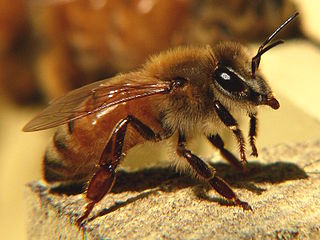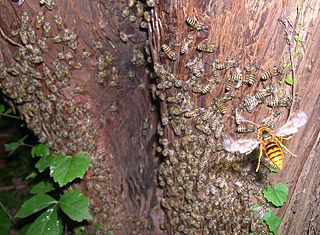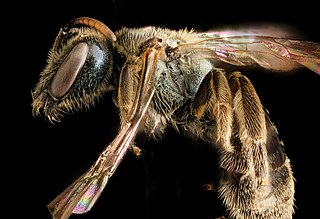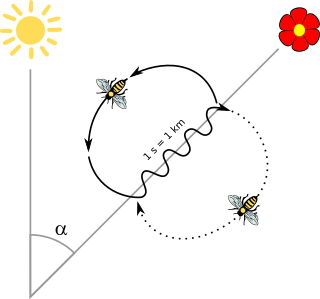
A honey bee is a eusocial, flying insect within the genus Apis of the bee clade. They are known for construction of perennial, colonial nests from wax, for the large size of their colonies, and for their surplus production and storage of honey, distinguishing their hives as a prized foraging target of many animals, including honey badgers, bears and human hunter-gatherers. In the early 21st century, only seven species of honey bee are recognized, with a total of 44 subspecies, though historically seven to eleven species are recognized. The best known honey bee is the Western honey bee which has been domesticated for honey production and crop pollination; modern humans also value the wax for candlemaking and other crafts. Honey bees represent only a small fraction of the roughly 20,000 known species of bees. Some other types of related bees produce and store honey and have been kept by humans for that purpose, including the stingless honey bees, but only members of the genus Apis are true honey bees. The study of bees, which includes the study of honey bees, is known as melittology.

The Africanized bee, also known as the Africanised honey bee, and known colloquially as "killer bee", is a hybrid of the western honey bee species, produced originally by cross-breeding of the East African lowland honey bee (A. m. scutellata) with various European honey bees such as the Italian honey bee A. m. ligustica and the Iberian honey bee A. m. iberiensis.

Karl Ritter von Frisch, was an Austrian ethologist who received the Nobel Prize in Physiology or Medicine in 1973, along with Nikolaas Tinbergen and Konrad Lorenz.

A bumblebee is any of over 250 species in the genus Bombus, part of Apidae, one of the bee families. This genus is the only extant group in the tribe Bombini, though a few extinct related genera are known from fossils. They are found primarily in higher altitudes or latitudes in the Northern Hemisphere, although they are also found in South America where a few lowland tropical species have been identified. European bumblebees have also been introduced to New Zealand and Tasmania. Female bumblebees can sting repeatedly, but generally ignore humans and other animals.

Royal jelly is a honey bee secretion that is used in the nutrition of larvae, as well as adult queens. It is secreted from the glands in the hypopharynx of nurse bees, and fed to all larvae in the colony, regardless of sex or caste.

Apis mellifera ligustica is the Italian bee which is a subspecies of the western honey bee.
Pesticides vary in their effects on bees. Contact pesticides are usually sprayed on plants and can kill bees when they crawl over sprayed surfaces of plants or other areas around it. Systemic pesticides, on the other hand, are usually incorporated into the soil or onto seeds and move up into the stem, leaves, nectar, and pollen of plants.

The dwarf honey bee, Apis florea, is one of two species of small, wild honey bees of southern and southeastern Asia. It has a much wider distribution than its sister species, Apis andreniformis. First identified in the late 18th century, Apis florea is unique for its morphology, foraging behavior and defensive mechanisms like making a piping noise. Apis florea have open nests and small colonies, which makes them more susceptible to predation than cavity nesters with large numbers of defensive workers. These honey bees are important pollinators and therefore commodified in countries like Cambodia.

Apis dorsata, the giant honey bee, is a honey bee of South and Southeast Asia, found mainly in forested areas such as the Terai of Nepal. They are typically around 17–20 mm (0.7–0.8 in) long. Nests are mainly built in exposed places far off the ground, like on tree limbs, under cliff overhangs, and sometimes on buildings. These social bees are known for their aggressive defense strategies and vicious behavior when disturbed. Indigenous peoples have traditionally used this species as a source of honey and beeswax, a practice known as honey hunting.

Deformed wing virus (DWV) is an RNA virus, one of 22 known viruses affecting honey bees. While most commonly infecting the honey bee, Apis mellifera, it has also been documented in other bee species, like Bombus terrestris, thus, indicating it may have a wider host specificity than previously anticipated. The virus was first isolated from a sample of symptomatic honeybees from Japan in the early 1980s and is currently distributed worldwide. It is found also in pollen baskets and commercially reared bumblebees. Its main vector in A. mellifera is the Varroa mite. It is named after what is usually the most obvious deformity it induces in the development of a honeybee pupa, which is shrunken and deformed wings, but other developmental deformities are often present.

The western honey bee or European honey bee is the most common of the 7–12 species of honey bee worldwide. The genus name Apis is Latin for "bee", and mellifera is the Latin for "honey-bearing", referring to the species' production of honey.

Colony collapse disorder (CCD) is the phenomenon that occurs when the majority of worker bees in a colony disappear and leave behind a queen, plenty of food and a few nurse bees to care for the remaining immature bees. While such disappearances have occurred sporadically throughout the history of apiculture, and were known by various names, the syndrome was renamed colony collapse disorder in late 2006 in conjunction with a drastic rise in the number of disappearances of western honey bee colonies in North America. Most European countries observed a similar phenomenon since 1998, especially marked in Belgium, France, the Netherlands, the UK, Greece, Italy, Portugal, and Spain, Switzerland, Germany and the Northern Ireland Assembly received reports of a decline greater than 50%. The phenomenon became more global when it touched some Asian and African countries too.

Apis cerana japonica is a subspecies of the eastern honey bee native to Japan. It is commonly known as the Japanese honey bee. This subspecies was determined, through an analysis of mitochondrial DNA, to have originally come from the Korean peninsula. They have been observed moving into urban areas in the absence of natural predators.
Honeybee Robotics Spacecraft Mechanisms Corporation is a small spacecraft technology and robotics company headquartered in Brooklyn, New York, with offices in Pasadena, California and Longmont, Colorado. It was established in 1983 by Stephen Gorevan and Chris Chapman. In June 2017, Honeybee Robotics was acquired by Ensign-Bickford Industries.

Bumblebees, like the honeybee collect nectar and pollen from flowers and store them for food. Many individuals must be recruited to forage for food to provide for the hive. Some bee species have highly developed ways of communicating with each other about the location and quality of food resources ranging from physical to chemical displays. Honey bees are known for their specialized dances, such as the waggle dance which recruit other bees to the precise location of the food source. Bumblebees are not capable of transmitting this type of detailed information. Instead, the nest serves as a hub where bees receive information about the foraging bouts of her conspecifics. Differences between the communication methods of honeybees and bumblebees are mainly due to differences in colony size and nest structure. Bumblebees are distinct from honeybees because they lack receiver bees and are not capable of trophallaxis. They deposit collected nectar directly into the honey pots and don't share information of the quality of the resource with other bees through nectar transfer. Another bee may sample the nectar brought into the nest, and if the colony is in need of food or the nectar is high quality she will likely go out foraging herself. Other means of alerting passive bees to a potentially rewarding resource include releasing pheromone signals and increasing physical activity. For information on communication methods in honey bees, see Bee learning and communication.

Slow bee paralysis virus (SBPV), not to be confused with acute bee paralysis virus, is a virus discovered in England in 1974 that infects honeybees, bumblebees, and silkworms through Varroa destructor mite infestations. The virus causes paralysis in the front two pairs of legs of adult bees eventually killing its hosts. The virus is in the iflaviridae family of viruses. Infection by iflaviridae viruses is among the leading cause of death of honeybee colonies. As bees and silkworms are of great economic and biological importance, the virus is the subject of ongoing research.
















